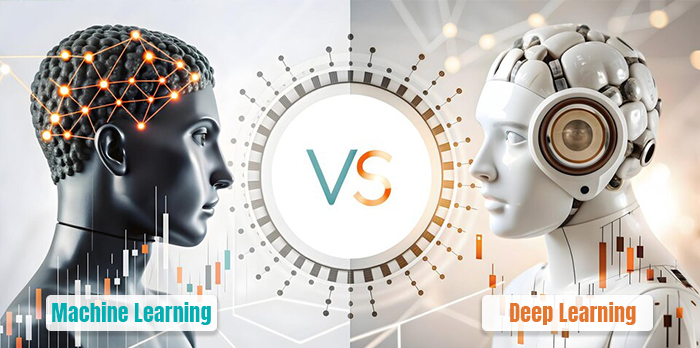Artificial Intelligence has two main areas of development called Machine Learning and Deep Learning which improve global industries through new methods. Both approaches work to teach machines through data but they employ distinct solution methods and building techniques for different business uses. Learning these differences helps firms researchers and developers use AI products correctly.
This article explains the differences between Machine Learning and Deep Learning by including their basic designs and data handling methods plus training needs and practical applications. It provides guidelines for picking between Machine Learning and Deep Learning features.
Understanding Machine Learning
Through Machine Learning technology computers automatically study datasets to foresee future outcomes without detailed programming instructions. ML models become better at processing data through updated internal functions that match outcomes against defined performance goals.
Key Components of Machine Learning
ML algorithms primarily work with decision trees, support vector machines (SVM), k-nearest neighbors (KNN) and random forest as ensemble techniques.
ML systems need computer-generated feature values from source data to generate forecasts.
Training Methods Including Supervised-Unsupervised-Reinforcement Learning Tell Us How ML Learns.
Structuring smaller datasets is what ML models need unlike Deep Learning which requires more complex data.
Standard CPU processing serves ML models because they do not need special graphics cards for operations.
Types of Machine Learning
Supervised Learning helps models study datasets whose entries and outcomes are marked for training purposes. (Like finding spam or identifying medical problems)
This learning method discovers natural data structures using datasets without labels. (Instance: customer clusters and unusual entries)
Reinforcement Learning creates models that develop abilities through positive and negative feedback during environmental interactions such as robotic and game-based projects.
Understanding Deep Learning
Deep Learning is a technical sub-area of Machine Learning that employs artificial neural networks to analyze and process vast amounts of data. Deep Learning models, especially deep neural networks, are derived from the organization and operation of the human brain.
Key Components of Deep Learning
Neural Networks – Deep Learning uses artificial neural networks (ANNs) comprising several layers such as input layers, hidden layers, and output layers.
Automatic Feature Learning – Deep learning models automatically learn features from raw data without the need for human intervention, unlike conventional ML.
High Data Dependency – DL needs huge amounts of labeled and varied data to produce high accuracy.
Computational Power – Deep Learning requires high computing power, such as GPUs and TPUs, to handle intricate models.
Training Time – Training deep learning models may take hours, days, or weeks, subject to data volume and model complexity.
Types of Deep Learning Architectures
Feedforward Neural Networks (FNNs) – Simple neural networks for uncomplicated classification tasks.
Convolutional Neural Networks (CNNs) – Principally for image processing and computer vision tasks.
Recurrent Neural Networks (RNNs) – Applicable for sequential data like time series, speech, and natural language processing.
Generative Adversarial Networks (GANs) – Used to create new data instances that are similar to training data.
Transformer Networks – The backbone of the latest NLP models such as GPT and BERT.
Related Post: Business Benefits of Artificial Intelligence (AI)
Key Differences Between Machine Learning and Deep Learning
Feature Engineering
ML needs manual feature extraction where domain experts choose the important features from the dataset.
DL models extract features automatically from raw data without any manual intervention.
Data Requirements
ML is efficient with smaller data sets and structured data.
DL requires enormous data sets with varied representations in order to learn well.
Algorithm Complexity
ML algorithms are simpler and more interpretable.
DL models have millions of interconnected neurons and are hence complex and less interpretable.
Computational Power
ML models execute well on normal CPUs.
DL models need high-end GPUs or TPUs because they perform computationally intensive operations.
Training Time
ML models train very fast, between seconds and a few hours.
DL models are much slower, often taking days or weeks.
Application Domains
ML finds frequent application in standard predictive modeling, recommendation systems, fraud detection, etc.
DL drives sophisticated applications like self-driving cars, speech recognition, and medical imaging.
Model Interpretability
ML models such as Decision Trees and Linear Regression provide decision-making transparency.
DL models are typically "black boxes" because of their intricacy.
Use Cases of Machine Learning
Spam Detection
Machine Learning algorithms identify emails as spam or not spam using pre-defined patterns and features like keywords and sender history.
Fraud Detection
Banks and financial institutions utilize ML models to identify fraudulent transactions by examining spending habits.
Recommendation Systems
Netflix and Amazon use ML-based collaborative filtering to recommend movies and products based on user interest.
Predictive Maintenance
Industries utilize ML to forecast equipment failures by examining past maintenance records.
Healthcare Diagnosis
ML assists in disease diagnosis by examining patient symptoms and medical history.
Stock Market Predictions
Market trends and past data are examined by ML models to forecast stock prices.
Natural Language Processing (NLP)
ML algorithms facilitate applications such as chatbots, sentiment analysis, and text summarization.
Use Cases of Deep Learning
Autonomous Vehicles
Deep Learning allows self-driving cars to identify objects, detect pedestrians, and make driving decisions in real-time.
Facial Recognition
DL models examine facial structures to recognize people in security cameras and social media platforms.
Speech Recognition
Deep learning is employed by virtual assistants such as Siri, Google Assistant, and Alexa to convert speech into text accurately.
Medical Imaging
Deep learning helps in the detection of diseases like cancer and tumors from X-ray and MRI scans.
Game AI
Gaming bots powered by AI employ Deep Reinforcement Learning to enhance gameplay and adjust strategies.
Language Translation
DL-driven neural machine translation (NMT) operates Google Translate and other live language translation services.
Content Generation
GPT and GANs generate text, images, music, and video.
Cybersecurity
DL models scan cybersecurity threats and identify anomalies in network traffic.
When to Use Machine Learning vs. Deep Learning
Use Machine Learning When:
The dataset contains few entries that follow a designed format.
Interpretability and explainability are important.
Computational resources are limited.
The regular algorithms can handle this problem.
Use Deep Learning When:
Large datasets are ready for training purposes.
The problem requires systems to recognize multiple complex data forms which include pictures, sound, and video streams.
The system has easy access to processing power including GPU and TPU resources.
Systems need to automate the development of input data from raw information.
Conclusion
Current artificial intelligence has two main branches that excel in different tasks and data situations. ML stays effective with smaller datasets yet simpler patterns while deep learning masters big and complex data sets with intricate information patterns. Polishing your selection depends on what problems need solving plus how much data exists and your available system strength along with precision demands. The distinction between ML and Deep Learning helps companies use AI in ways that work best for their development.
Are you looking for an AI development company in India to implement cutting-edge Machine Learning and Deep Learning solutions? Contact foduu.com – a leading AI and ML development company in India, offering innovative and customized AI solutions tailored to your business needs.




